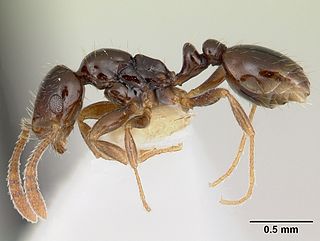
Paratrechina is one of seven ant genera in the Prenolepis genus-group from the subfamily Formicinae. Six species are included in Paratrechina; one of which, the longhorn crazy ant, is a widespread, pantropical pest.

Leptomyrmex, or spider ants, is a genus of ants and a distinctive member of the ant subfamily Dolichoderinae. Commonly known as "spider ants" for their long legs and spider-like movements, these orange and black ants are prominent residents of intact wet forest and sclerophyll habitats throughout their range. One extant species, Leptomyrmex relictus, is known from central Brazil; otherwise, the global distribution of this genus is restricted to eastern Australia, New Caledonia and New Guinea, as well as the nearby Indonesian islands of Aru and Seram.

Megalomyrmex is a genus of ant in the subfamily Myrmicinae. The genus is known only from the Neotropics, where some of the species are specialized parasites or predators of Attini.

Cyphomyrmex is a genus of fungus-growing ants found primarily in South and Central America. However, some species do come up to the southern portion of North America. They grow a variety of fungi in the tribe Leucocoprineae. Most fungal gardens are grown in small nodules, some species to cultivate entire mycelium, though. Colonies are monogynous and are relatively small with about 100 workers on average.

Adelomyrmex is a genus of ants in the subfamily Myrmicinae. Species of Adelomyrmex are small, litter-inhabiting ants most often collected in Berlese and Winkler samples. Although the genus and its relatives have a pantropical distribution, Central American cloud forests are the only places where they are abundant and diverse.

Nylanderia is a large genus of ants in the subfamily Formicinae. The genus has a nearly cosmopolitan distribution with species inhabiting a wide array of habitats in almost all geographic regions. Nylanderia, currently containing over 110 species, is an ecologically important genus, with some species reported as being invasive. The ants are small to medium in size and range in color from pale yellow to black.

Paraparatrechina is a genus of small ants in the subfamily Formicinae. The genus contains 31 species distributed in the tropics of Africa, Asia and Australia.

Leptogenys is a genus of ants in the subfamily Ponerinae. Leptogenys is the most diverse ponerine ant genus in the world; it is widespread throughout tropical and subtropical regions and there are over 260 extant species described. Most species have ergatoid queens, and many have falcate, bowed mandibles and are specialists on isopod prey.
Megalomyrmex mondabora is a Neotropical species of ants in the subfamily Myrmicinae. Known from Costa Rica. In Costa Rica this species occurs in wet forest habitats, typically in mature rainforest. Collections are from sea level to 800 m elevation on the Atlantic slope of the Cordillera Volcanica Central, Cordillera de Talamanca, and Cordillera de Guanacaste. It is a specialized nest parasite of attines and is found most often in nests of Cyphomyrmex cornutus. It cohabits with C. cornutus in their nests, feeding on both host brood and the host's fungal symbiont.
Megalomyrmex mondaboroides is a Neotropical species of ants in the subfamily Myrmicinae. Megalomyrmex mondaboroides occurs in lowland wet forest habitats in Panama and Costa Rica. Colonies have been collected in the nests of small attines, primarily Cyphomyrmex costatus and Apterostigma goniodes. In Costa Rica a worker was collected in a Winkler sample of sifted leaf litter.
Megalomyrmex wallacei is a Neotropical species of ants in the subfamily Myrmicinae. Megalomyrmex wallacei can be found in Brazil, Guyana, Colombia, Costa Rica. This species occurs in mature wet forest, usually low-elevation rainforest. Brandão (2003) reports the species nesting under leaves on the forest floor, in colonies of up to 300 workers.
Megalomyrmex modestus is a Neotropical species of ants in the subfamily Myrmicinae. Known from Costa Rica, Panama, Colombia, Venezuela.

Megalomyrmex drifti is a Neotropical species of ants in the subfamily Myrmicinae. The species is widespread in tropical South America, north through Central America to southern Mexico.
Megalomyrmex foreli is a Neotropical species of ants in the subfamily Myrmicinae.
Megalomyrmex adamsae is a Neotropical species of ants in the subfamily Myrmicinae. Megalomyrmex adamsae, known from Panama, is very similar to M. symmetochus, known from Costa Rica to Panama.

Megalomyrmex incisus is a Neotropical species of ants in the subfamily Myrmicinae. The species is known from southern Mexico south to central Brazil and Peru.
Megalomyrmex miri is a Neotropical species of ants in the subfamily Myrmicinae. Known from Costa Rica. This species is known only from the type specimens and has no biological data. It is extremely similar to M. wettereri in color, size, shape, measurements, and pilosity. It differs in having a complete foraminal carina and some transverse rugosities on the anteroventral petiolar process.
Megalomyrmex wettereri is a Neotropical species of ants in the subfamily Myrmicinae. Megalomyrmex wettereri is known from two lowland rainforest sites: Barro Colorado Island in Panama and La Selva Biological Station in Costa Rica.

Megalomyrmex silvestrii is a Neotropical species of ants in the subfamily Myrmicinae. Megalomyrmex silvestrii is widespread in the mainland Neotropics from Mexico to northern Argentina. This species occurs in moist to wet forest habitats, from sea level to 1100 m elevation. It nests in small chambers in rotten wood or opportunistically in other small cavities in the soil. Colonies have been found in small attine nests and alone, suggesting it is a facultative predator of small Attini.
Megalomyrmex nocarina is a Neotropical species of ants in the subfamily Myrmicinae. Megalomyrmex nocarina occurs in mature wet forest habitats of the Atlantic slope of Costa Rica. It occurs from near sea level to 1110 m elevation. It is known exclusively as isolated workers in Winkler samples of forest floor litter.










